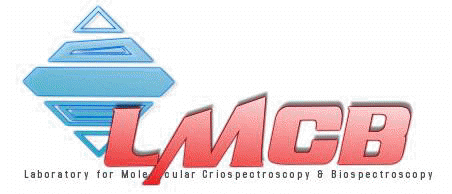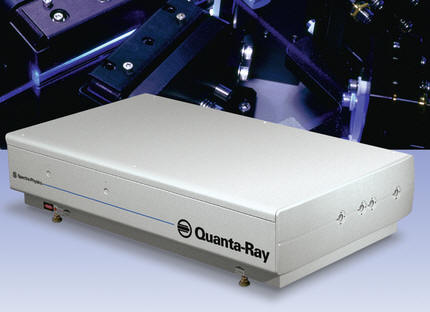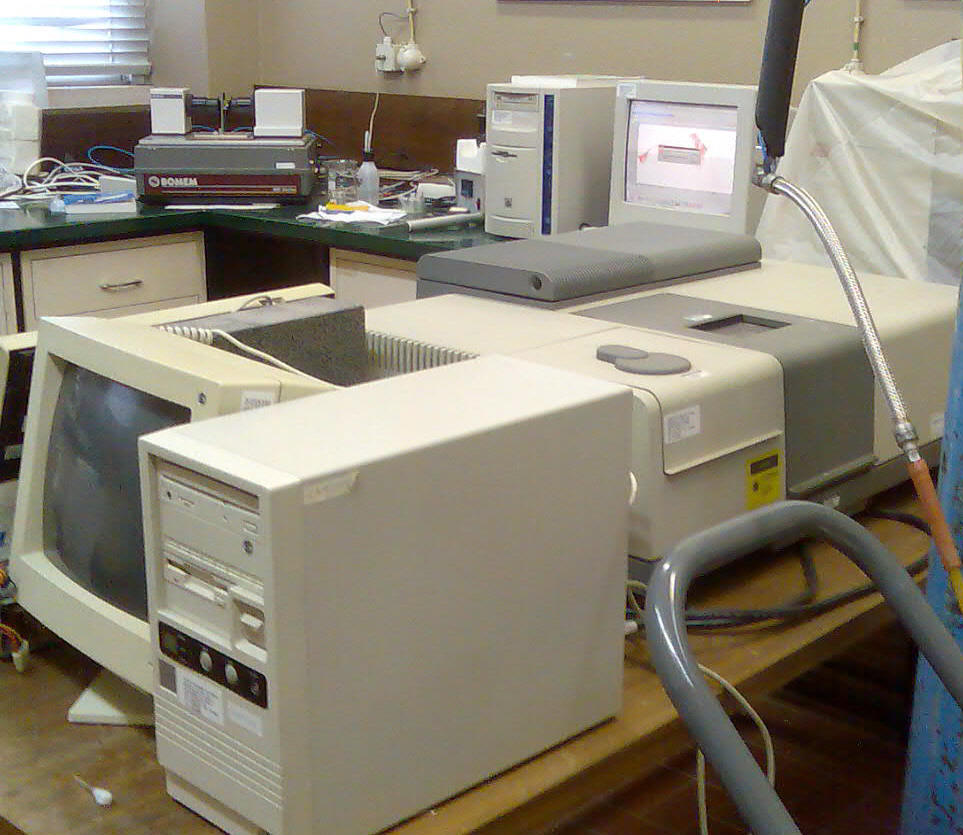

Research Team Members:
Rui Fausto
(Full Professor)Igor Reva
(post doc)Andrea Gómez-Zavaglia
(post doc)Agnieszka Kaczor
(post doc)Ermelinda Maçôas
(post doc)Susana Jarmelo
(post doc)Archna Sharma
(post doc)Nihal Kus
(Ph.D student)Susana Breda
(PhD student)Pablo Mobili
(PhD student)Luís Frija
(PhD student)Ana Borba
(PhD student)Susy Lopes
(PhD student)Juracy Junior
(PhD student)Cláudio Nunes
(PhD student)Rui Almeida
(M.Sc student)Alcides Simão
(M.Sc student)Luís Duarte
(Lic. BIC holder)Ana Casteleiro
(student)
On
Going Research Projects:
Energy Relaxation Processes in Low Temperature Matrix-Isolated Molecules
The general problem considered in this project is vibrational energy redistribution/relaxation in simple molecules isolated in matrices at low temperature. The project focus on the processes following vibrational excitation carried out either in the mid infrared (fundamental vibrations) or near infrared (overtones and combination tones).
Vibrational relaxation and redistribution processes are still rather far from being well understood. In an idealized scenario, the laser used to promote vibrational excitation deposits energy in a particular bond or functional group; this vibrational excitation then causes this bond or group to undergo a selective chemical reaction or specific conformational rearrangement and give a desired product. Unfortunately, reality is by far more complex, since most of times dissipative relaxation processes will trend to redistribute the energy and this will result in the loss of specificity. For example, thermal, statistic energy redistribution, may lead to disruption of the weakest bond in a molecule after vibrational excitation of a different (stronger) bond, or, in the limit of complete energy randomisation, to simple thermal bulk heating. On the other hand, a better understanding of these processes would certainly open new perspectives in the field of molecular photochemistry and lead to the development of novel techniques of “molecular surgery” with predictable important practical applications.
In this project, a systematic procedure of selective irradiation (in both the mid and near infrared regions) of a particular molecular species (conformer) and vibrational mode of a series of judiciously selected molecules are being carried out, followed by spectroscopic probing of the intramolecular energy redistribution/relaxation processes undertaken by comparative analysis of infrared spectra prior and after (or during) irradiation of the sample. The molecules under study are simple organic compounds, whose vibrational spectra and conformational characterization have already been made previously in our Laboratory. Isotopically modified derivatives of these compounds are being synthesized and studied by the same methodology, enabling to increase substantially the experimentally accessible relevant data on a given compound, and, in particular, to look in deep detail to the mass effects on vibrational energy redistribution. The influence of matrix trapping sites on the photochemical processes (e.g., matrix-site selectivity; efficiency of the photochemical processes) is also being investigated in this project.
Theoretical studies are also systematically carried out on the studied systems, in order to help interpretation of photochemical and spectroscopic experiments. In particular, electronic and vibrational properties of the molecules under study are obtained by using either ab initio (at the MP2 level of theory) or Density Functional Theory (DFT) based methods, and the preferred reaction paths that can explain the observed photochemical reactions (e.g., conformational isomerizations, tautomerizations, fragmentation reactions, rearrangements) are computed at the same levels of theory, in order to obtain solid theoretical foundations for the interpretation of the experimental data. Finally, the influence of the matrix on the relevant properties and on the observed photochemical reactivity are also studied theoretically either using simple continuous models (e.g., the Self Consistent Reaction Field method) coupled with DFT calculations or by Molecular Dynamics.
On the whole, these studies will certainly provide solid fundamental bases for understanding vibrational photochemistry and for the development of new methods with relevant practical applications, for example, in the fields of phototherapy, synthetic photochemistry and molecular biology.

Photochemistry and Matrix Isolation Spectroscopy of Molecular Species with Astrophysical and Atmospheric Relevance
The main objectives of the proposed project consist in the study of the structural details, spectroscopy and photochemical reactivity of molecular species of astrophysical interest, in laboratorial experimental conditions that mimic their real conditions in the interstellar space or frozen planetary bodies. The project also intends to contribute to the understanding of the atmospheric photochemistry. Nowadays, when the atmospheric pollution becomes more and more notable, it is very important to gain knowledge of the photochemistry of pollutants.
The project take advantage from the unique capabilities of the matrix-isolation technique coupled with IR spectroscopy and quantum chemical calculations, as well as from the world-quality matrix isolation facilities and human accumulated know-how existing in the LMCB.

A Combined Thermodynamic and Spectroscopic Approach to the Study of Intermolecular Interactions in Organic Compounds
This research project focus on the study of intermolecular interactions in a series of biologically relevant organic families of compounds and their relevance to polymorphism, phase transition properties and solution processes. Globally, the investigation is directed essentially to problems usually considered by crystal engineering, since the study of the whole chain of processes: monomeric solute ® molecular aggregates in solution ® solid phases separated from a given solution ® solid-solid phase transitions, is considered in this research programme. The project takes advantage of the essentially complementary nature of the thermodynamic and spectroscopic methods to look simultaneously at the macroscopic scale and at a molecular level. Such approach enables a very precise characterisation of the macroscopic phenomena under analysis and to evaluate the most important processes that determine these phenomena at a molecular level. In addition, as a complement to the experimental studies, up-to-date molecular modelling methods are systematically used, to provide solid theoretical foundations to the physicochemical interpretations extracted from the experimental data.
The specific objectives of the project can be summarised as follows:
(A) - Obtaining a detailed structural, spectroscopic and thermodynamic description of the monomers of the various systems under analysis, as a starting point to the study of the corresponding aggregates and the relevant macroscopic phenomena. Enabling a detailed knowledge of the molecules which act as constituting units of the complex systems to be studied later on, these studies assume particular importance as a way to get the basic information required by the studies that look at the more complex problems and constitute the main objective of the project. The equilibrium structures of the various possible conformers of the different monomeric species, their relative energies, vibrational spectra and main intramolecular interactions are obtained using noble gas matrix isolation spectroscopy and theoretical calculations at the required levels of theory (ab initio or DFT quantum chemical calculations or molecular mechanics).
(B) - Characterising the fundamental intermolecular interactions involved in the formation of aggregates of the different compounds under analysis, for the pure substances and in solution of different solvents. Particular emphasis is given to the study of the hydrogen bond formation processes. These studies are undertaken by a concerted vibrational spectroscopy and calorimetry (differential calorimetry and thermomicroscopy) approach, complemented by theoretical calculations. These later are performed at various levels of approximation, including the simulation of the nucleation processes by molecular dynamics calculations carried out using the Cerius2 software.
(C) - Determining the different possible phases of the compounds under study, obtained from crystallisation from different solvents, in a wide range of temperatures, going from near the absolute zero to above room temperature, by differential scanning calorimetry and vibrational spectroscopy, and to obtain the phase transition thermodynamic properties.
(D) - Characterising the different phases observed from a structural point of view, explain their occurrence and main features in terms of intermolecular interactions between their constituting units, and establishing fundamental structure/properties relationships that may be useful to understand the structural, thermodynamic and spectroscopic properties experimentally observed in the families of molecules under analysis, as well as some aspects of their physicochemical behaviour.

A Multidisciplinary Approach for the Understanding of the Mechanisms of Action of New Cryoprotectants at a Molecular Level
The storage of biological material at sub-zero temperatures plays nowadays an essential role in several domains of human activity, in particular in Medicine and Biology. During the preservation procedures, the cell membrane is the main target for damage. The injury caused by freezing usually destroys the barrier for ion permeation and, in consequence, a collapse of the membrane potential is produced. It becomes clear that the preservation of biological membranes is essential in storage processes. Hence, the choice of an adequate cryoprotectant is essential to successfully attain this aim.
In general, the target of cryoprotectants is the membrane. However, very often the experimental research intending to understand the mechanisms of such interactions is complicated by the lack of reliable data on the constituting units and specific interactions among them. A successful analysis of phenomena such as aggregation and molecular recognition, which are relevant to cryoprotection, requires a detailed knowledge of the basic information on the structure and properties of the interacting chemical groups that might be obtained by theoretical models or gas phase studies. A better approach to this problem is to look at those species in an inert condensed media, where the specific “solute”/”solvent” interactions are minimized but some of the most fundamental conditions of the “real” system under study are maintained (e.g., packing effects, reduced mobility). The matrix-isolation technique, where the target molecular species are embeeded in a low temperature inert matrix, satisfies the requisites above mentioned.
To attain the objectives of this work, a precise physicochemical characterization of a series of substances and mixtures of substances (derivatives of aminoacids, hydroxyacids and polihydroxylated compounds), both at the molecular and thermodynamic levels, needs to be first established. Spectroscopic and calorimetric methods are being used complementary to fulfill this aim. Studies on matrix-isolated monomeric species and their small aggregates, cryogenic solution, crystals and glassy states of these potentially new cryoprotectants at very low temperatures (9K) are also being undertaken. On the whole, they are hope to provide a deep insight on the structures and spectroscopic properties of the target compounds as well as on their intermolecular interactions, particularly H-bonds. Molecular modeling methods are also being systematically used, to provide solid theoretical foundations to the physicochemical interpretations extracted from the experimental data.

Cryoprotection: From the Physical-Chemistry of Cryoprotectants to Long Term Preservation of Biological Material
Long term cryogenic storage of biological material, like living cells and tissues, is an active area of research due to its easily recognisable social impact in several areas of the human activity (e.g., transplantation). In general, the methods developed for the cryopreservation of cells have not proved to be directly transferable to multicellular, organised tissues and organs. For these systems, vitrification (glass formation) has been recognised as the most promising approach to overcome the problem of ice formation during freezing, which in the case of the highly organised structures of an organ or tissue has been shown to result in devastating and fatal damage.
Vitrification requires that the biomaterial be perfused with a suitable cryoprotectant, the role of which is to protect the material from the physicochemical and biochemical effects of low temperatures, and also to promote the formation of the vitreous state. The choice of a suitable cryoprotectant is critical to a successful vitrification and depends on a number of factors, including solute toxicity, solute/water interactions and cooling rate. Unfortunately, with the cryoprotectants presently used, the concentration needs to be high to achieve complete vitrification and thus toxicity becomes a problem.
This research project aims to develop new more efficient vitrifying procedures involving new cryoprotectants which present lower toxicity than those actually available.
To attain this fundamental objective, a precise physicochemical characterisation of a series of substances and mixtures of substances, both at the molecular and thermodynamic levels, need to be first established. In this project, this is achieved by complementary use of spectroscopic and calorimetric methods. In addition, as a complement to the experimental studies, up-to-date molecular modelling methods are systematically used to provide solid theoretical foundations to the physicochemical interpretations extracted from the experimental data. Once a suitable cryoprotectant system, showing the desired physicochemical properties, is found, it still must be tested with respect to its intrinsic toxicity, because, even in the most favourable expected conditions, relatively large cryoprotectant concentrations must be used in order to attain the desired physicochemical conditions. Thus, in this project, the evaluation of the intrinsic biological toxicity of the identified candidate systems to act as cryoprotectant agents is also investigated.

Main Equipment:
4 Research level FT-IR spectrometers (ATI-Mattson Infinity Series AR60, with resolution 0.125 cm-1 in mid-infrared; Nicolet 740, with resolution 1 cm-1, equipped to work in the mid, near and far infrared regions and connected to an infrared microscope; Bomem MB104, with non-hygroscopic ZnSe optics and resolution 1 cm-1 for routine studies in the mid-infrared and part of the near infrared regions; Nicolet 6700, with resolution 0.09 cm-1 in mid-infrared)
1 Nd-Yag Quanta-Ray PRO-230-10 Laser with BeamLok-355 and EEO-355 Enhanced Energy Options and second and third harmonic generators
1 Spectra-Physics MOPO SL, with FDO-970, IEEE-488 and MAP-SL options (bandwidth 0.2 cm-1)
2 Fluorimeters (Perkin-Elmer MPF-3 and SPEX DM300)
1 UV/Visible spectrometer (Shimadzu UV-2100)
3 Cryogenic systems to work at temperatures close to the absolute zero, which
include as main component closed-cycle helium cryostats (APD-DISPLEX), capable
of providing temperatures >= 6.5 K
- 3 high-vacuum systems (primary rotative + turbomolecular pumps ; pressure
values attained: 10-7-10-9 torr)
Set of sampling devices suitable for infrared and uv/visible spectroscopic measurements at low temperature, compatible with the cryostats
Compatible monochromator SPEX 500M for irradiation experiments at low temperature
1 Low/high temperature cell for conventional spectroscopic studies (Specac; home made)
1 Cryogenic system for continuous flux low temperature experiments, with temperature controllers and vacuum systems
Leak detector system
Pyrolisys system interfaced with the cryostats
2 Silicon Graphics O2 workstations and software for molecular modelling (Cerius2 and Insight/Discover)
Several PC computers
Software for spectroscopy, molecular modelling and quantum chemical calculations (e.g., Gaussian 98/GaussView, Hyperchem, Winfirst, Grams 32/AI, Origin 7.5, Cerius2, Insight/Discover, JopenMOl, WebLab Viewer, Mol2Mol, ArgusLab, Jmol, MolWin, ISIS Draw, Molda, Build-G, Vibrat, Transformer, Balga).